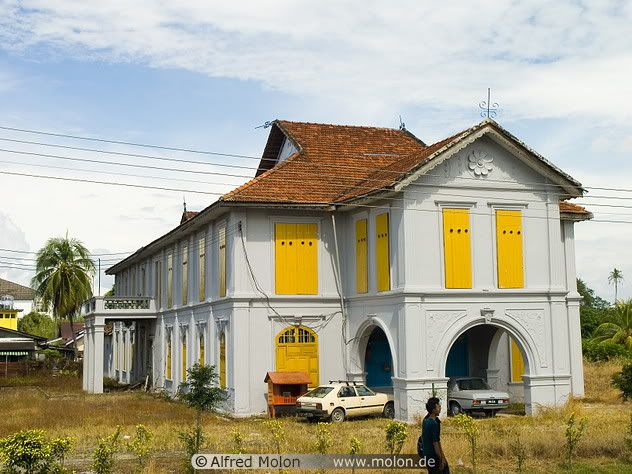Archive for January 2011

Here are some of the famous hotels in Teluk Intan.
click on the Hotel's name for more information.
ANSON HOTEL
Jln Sekolah,
36000 Teluk Intan,
Perak Darul Ridzuan,
Malaysia
Tel: 05-622 6166 / 05-622 6167
Fax: 05-622 6168
ansonhotel@mhc.com.my
click on the Hotel's name for more information.
ANSON HOTEL
Jln Sekolah,
36000 Teluk Intan,
Perak Darul Ridzuan,
Malaysia
Tel: 05-622 6166 / 05-622 6167
Fax: 05-622 6168
ansonhotel@mhc.com.my
No 24 Jln Changkat Jong
36000 Teluk Intan Perak
No Tel : (605) 622 3755, 3756, 3751
Fax : (605) 621 6399
email :info@angsokahotel.com
website : www.angsokahotel.com
HOTEL INTAN
6 Jalan Sultan Abdullah
36000 Teluk Intan, PERAK
36000 Teluk Intan, PERAK
No Tel : 05-622-1233
Other Hotels that may be suitable for you.
click on the link below

The leaning tower of Teluk Intan is the Malaysia equivalent of the world famous Leaning Tower of Pisa in Italy. It islocated in the centre of the town of Teluk Intan, Perak. The tower is slanted leftward similar to Tower of Pisa. It is 25.5 metres tall and from outside, it looks like a 8 storey building. In actual fact, you will find out as you go inside that the building is divided into 3 storeys.
What do you think ??
 |
| The Leaning Tower of Teluk Intan, Perak |
 |
| The Leaning Tower of Pisa, Italy |
What do you think ??

The heritage trail in Teluk Intan, with the theme ‘colonial port’, highlights the many structures that were built as the town developed.
TAKE a leisurely walk along the Teluk Intan town centre and you will find yourself following a heritage trail dotted with colonial buildings, old shophouses with dying trades as well as streets that show the influence of cultures and the people who contributed to the town’s history.
Named the Colonial Port of Teluk Intan Trail by the Perak Heritage Society, the heritage walk reveals in depth, the history, culture and heritage of this charming old town.
Perak Heartland
Formerly known as Teluk Anson, Teluk Intan was the “heartland of the Perak Kingdom” and it was here that Perak’s rulers held court from 1528 until Kuala Kangsar became the Royal Town in 1877.
Historically, it was the port for Kinta from the 1870s to 1880s and up to the early 20th Century, with jetties at Durian Sebatang and Batak Rabit. Archibald Edward Harbord Anson, the last Lieutenant Governor of Penang, who drew the plan of the town in 1882, had named it Teluk Anson after himself.
It was once the largest of Malaya’s minor ports, with regular steamer services to Penang and Singapore. In 1903, Teluk Anson was known as “our great Southern Port”. Its decline came after the expansion of the railway line north and south of Tapah Road in 1909.
Legend of Mak Intan
Teluk Anson was renamed Teluk Intan (Diamond Bay) in 1981 just before its centenary. The name comes from Teluk Mak Intan, one of the oldest settlements in the area.
According to a legend, Mak Intan, a Mandailing cloth merchant, founded the settlement. She was frolicking in the bay when she lost a diamond hairpin but she had staked her territory.
Walk The Walk
The Colonial Port Heritage Walk covers the District Courthouse, Hongkong and Shanghai Banking Corporation, Post Office, Police Station, Leaning Clock Tower, Sri Thandayuthapani Temple, Hock Soon Keong Temple, Methodist Episcopal Church, Church of Saint Anthony, Horley Methodist Primary School and Masjid Batak Rabit.
The single-storey Police Station facing the river is the oldest historical building here. Its high pitched roof resembles a fort. It was once used as a Custom house and later a police station.
The Post Office is of pre-World War II architecture, incorporating the 3-3-3 and 3-4-3 windows in rhythm design. The modern post-war interpretation of classicism lies in the building of Hongkong and Shanghai Banking Corporation.
The District Courthouse, built as a church during the 1890s, is no longer in use. But despite modern extensions, its original facade is retained.
The highlight of the trail is a visit to the must-see landmark, the Leaning Clock Tower. The three-storey circular brick structure was built in 1885 to house the town’s water tank. There are seven tiers of fringe roofs, a timber post-and-bracket structure that gives the tower its pagoda-like appearance – an impression further reinforced by the use of Chinese half-round tiles and green glazed grilles like balcony railings above the roofs. The clock was installed in 1894.
Another interesting landmark is the Sri Thandayuthapani Temple (1899), founded by the Chettiar community. Their past presence was an indication of the commercial potential of Teluk Intan. The temple, dedicated to Lord Murugan, comprises of decorative elements, fine plaster sculptures, garbagraham (sanctuary) of the main deity and vimana (sculpted tower with figurines of deities).
The first Chinese settlers were Penang Hokkiens who built the Hock Soon Keong temple in 1883. The roof ridge with beautifully decorated upturned eaves is characteristically Hokkien.
Built in 1936, the Methodist Episcopal Church (Tamil Methodist Church) founded by the Anglo-Tamil School, has an impressive marble plaque at the entrance, simple embellishments in repetitious ventilation slots and trefoil arches.
Next is the Church of Saint Anthony (1894), a three-storey porte cochere tower topped with an elegant steeple. The simple cross plan of the church can be easily seen.
Horley Methodist Primary School, founded in 1898, was the first English school. The final stop is Masjid Batak Rabit, designed after the 15th Century Masjid Agung at Demak Java and early 18th Century Masjid Kg Laut, Kelantan.

WHILE Italy is proud of its world-renowned Leaning Tower of Pisa, we too have our own, the Leaning Tower of Teluk Intan. The pagoda-shaped tower is a major tourist attraction in Perak’s third largest town.
This historical landmark was originally built by a contractor, Leong Choon Cheong, in 1885 as a water storage tower for the 800 residents in the area. At the same time, the 25.5m building also served as a beacon to guide ships into Teluk Anson as the town was called back then.
Apparently, the original name of the town was Teluk Mak Intan, named after a wealthy Mandailing cloth trader. Legend has it that Mak Intan lost a diamond hairpin while playing in the bay and so the name was given to commemorate the incident.
Then in 1882, it was renamed Teluk Anson in honour of the last Penang Lieutenant-Governor, Major-General Sir Archibald Edward Harbord Anson who was said to have drawn up the modern plan for the town in the late 1890s.
In 1982, during the town’s 100th anniversary celebrations, the Sultan of Perak proclaimed that the name would be changed to Teluk Intan.
Originally called the High Clock Tower, the building appears to be eight-stories tall but in reality, there are only three different levels with the water storage area at the highest position.
This brick and wood structure started tilting in a north-westerly direction about four years after it was completed. This was attributed to ground movement caused by an underground stream that was not detected when the site was selected.
During two major floods in 1889 and 1895, the lower section of the tower was submerged. It was used as an observation post during the Japanese Occupation due to its height. After the war, it became the Boy Scouts headquarters.
Today, its only function is as a clock tower. Despite its age, the clock which was manufactured in London more than a century ago, still chimes without fail every 15 minutes.
The photograph shown here was taken from a complete set of 24 large photographic cards entitled Malayan Scenes, issued by Carreras in 1928.
Clearly at that point of time, the tower, located at the end of Jalan Selat, did not show the high degree of inclination that is visible today.

Some 6km from the town of Teluk Intan heading towards Hutan Melintang, also the road to Lumut and Manjung, can be seen and old mosque beside the road which has its own history. This is Masjid Batak Rabit, the main mosque of Perak once upon a time...
In all our readings and research regarding the history of Perak, not once have I found anyone stating the mosque was one of the main mosque of Perak. Strangely, while writing this article at an Internet Cafe in Sungai Petani, Kedah, suddenly the rather big statement came out. When did this mosque ever become the main mosque of Perak? Why did I say this despite the fact that as far as I knew, nobody else have said so? What is this inspiration which suddenly came about?
Praise be to God! Before this, we never thought the mosque used to be the main mosque of Perak. What's important to me, it has personal connections to myself as the cemetery next to is an area reserved for my family members while the mosque itself was built within a land given out by the family, the family of Laksamana Raja Mahkota (Royal Admiral) of Perak. And so this story was original started as a nostalgic reflection on the mosque to be shared here. Never thought the narration could suddenly change direction like this!
It is known by researchers on history, the area around Kampung (the village of) Batak Rabit was once the centre of Perak's administration under the rule of Sultan Abdullah Muhammad II (1874-1877). Too bad, he was exiled to the Seychelles Islands in the waters of Africa as he was said to be involved in the killing of the English Resident to Perak, J.W.W. Birch in 1875... An incident which happened because the Malays were not happy with the Pangkor Treaty of 1874 which gave the English the room to hold sway in the Malay lands.
This incident and the following Malay-English war saw the fort of Sultan Abdullah, the palace and many related buildings destroyed by the English. Official history as noted now seemed to pass by the fact that Batak Rabit was the Perak capital of the time. Too much focus was given to the fight of Datuk Maharajalela, the Malay noble said to be most involved in the killing of Birch. And so not many know about how the Malay's crusade against the English was planned in Batak Rabit by the side of Sultan Abdullah, especially by his closest aide, Laksamana Raja Mahkota Muhammad Amin who was the great-grandfather to my grandfather!
How close are they? The official genealogy said that Sultan Abdullah and Laksamana Muhammad Amin are third cousins from the female side. But the unofficial one mentioned by certain people says they are first cousins on the male side, in fact the Laksamana can become the king! Ah... This words might not please certain people who wants the Laksamana to considered as just another noble! Let it be... Some day people will know the truth... Just like in Aceh during the olden days when a king to be often becomes an admiral (the Laksamana) first to go on the ground and get involved in the fights for the people.
Back to Masjid Batak Rabit's role as the main mosque of Perak once upon a time. It is in the old Malay custom, where there is a fort or city in which the ruler resides, there also must exist a mosque which becomes the king's and the country's main mosque. So what is so strange if it's true Masjid Batak Rabit was once the main mosque of Perak?
So it follows, if it is clear, the mosque was once the main mosque in Perak, so what does it say about the cemetery besides it? Under the old Malay administration and building code, just like there must be the main mosque next to the king's palace, there also must exist a royal burial ground besides. Methinks, enough of this words. Those who understand would know the truth and the true status of the Laksamana Raja Mahkota family...























